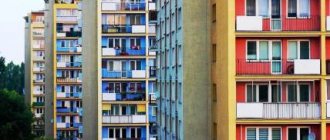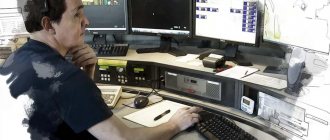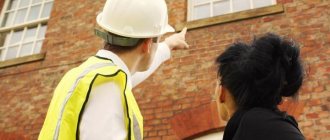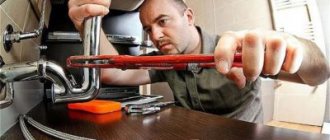Sanitary cleaning
As soon as a person crosses the threshold of the apartment, the common area begins. And the responsibility for cleaning the entrances of residential buildings falls on third-party organizations. And sometimes residents and the management company have a lot of disputes in resolving this issue. Most often, a cleaner is assigned to several objects and works on certain days, in accordance with the rules for cleaning the entrances of apartment buildings. If a responsible company does not monitor the situation with this process, then it is a clear violation of the law.
Rules for cleaning an apartment building are specified in special documentation in accordance with GOST R 51617-2014. In case of violations, the performer is responsible. Homeowners pay for cleaning; the cost is stated in the receipt. Payment calculations take place at a house-wide meeting and are approved by the residents. Not only flights of stairs should be cleaned, but also handles, railings, and mailboxes. Dry and wet cleaning must be carried out in compliance with all sanitary standards.
The regulations for cleaning the entrances of residential buildings are prescribed in regulatory documents, which indicate when, at what time and how the action is carried out. Each cleaner must clearly know the regulations and follow all the rules for cleaning the entrances of residential buildings. Basic regulations and standards:
- №170;
- №290;
- housing code;
- Directive of the State Construction Committee No. 139.
The treatment is carried out to keep the house clean and give it freshness. The entrance is a public space and frequently visited. This is a good environment for the proliferation of dangerous bacteria.
Key points of cleaning:
- Sanitary cleaning of house entrances allows you to destroy pathogenic microorganisms and prevent further occurrence.
- The cleaner must have a medical certificate and confirmed qualifications. Cleaning entrances in an apartment building is carried out with special detergents that effectively cope with their task and, at the same time, do not have a specific strong odor to protect the health of residents.
- All surfaces are processed. Particular attention should be paid to handles, railings, and windows.
- It is prohibited to use the same cloth for wiping floors and railings.
- Cleaning of an apartment building must begin from the upper floors and end with the entrance to the house.
- When a garbage chute is installed, it is also subject to cleaning and cleaning.
- If insects are noticed in the house, disinfestation is carried out with special preparations.
- A responsible company should provide the cleaner with the necessary cleaning equipment.
The legislation clearly defines sanitary standards. They are also recorded in order No. 191 of August 22, 2000. In case of non-compliance with these standards, residents of the house have the right to submit an application. And those responsible will be punished in the form of fines and removal from their positions.
Features of the job description for a cleaner at the entrance
As a rule, the job description of service personnel, in particular janitors and cleaners, predetermines their functional responsibilities, rights, and area of responsibility.
What a cleaner should know:
- Sanitary and hygienic standards for maintaining the territory and premises;
- Basic rules for carrying out cleaning work;
- Types of detergents that should be used when cleaning;
- Concentration of detergents, norms and rules for their safe use;
- Rules for the correct use of technical equipment.
Responsibilities of the cleaner, which are regulated by the job description:
- Ensuring daily wet cleaning of: staircases, flights, areas in front of the entrance;
- Remove dust and carry out wet cleaning of railings, staircases, window sills, and mailboxes;
- Carry out general wet cleaning (frequency 1 week), in particular washing entrances in an apartment building, washing railings, windows and window sills, mailboxes;
- Remove cobwebs from ceilings and walls monthly;
- Make sure that the windows in the entrance are always closed;
- Strictly follow the rules and regulations of hygiene;
- Order disinfectants and detergents, cleaning equipment directly from the head of the department;
- Avoid rudeness towards residents;
- Unconditionally carry out other instructions from superiors related to the duties regulated by the instructions of the cleaner or janitor.
Key points for which maintenance personnel bear full responsibility:
- Gross failure to fulfill one's direct duties;
- Failure to comply with orders, personal instructions or instructions from the administration;
- Strict violation of labor standards and rules, fire safety precautions (which were established by the organization);
- Refusal to perform work in the house properly: efficiently and in a timely manner;
- Direct responsibilities of the janitor: safety and serviceability of technical equipment.
An important issue is the direct control by residents of cleaning in an apartment building.
In this case, there is the following mechanism:
- All employees carry with them the “Certificate of Acceptance of Work Completed on the Territory of Public Areas”;
- The document states the address of the house, the entrance number, and also indicates the type of cleaning work performed;
- On one side of the act, the site master signs, on the other, one of the residents of the entrance (necessarily an adult) signs it, indicating their initials and contact information.
Who should clean the entrances?
Previously, the responsibility for caring for the house fell entirely on the shoulders of the residents. Cleaning schedules were drawn up, and the owners took turns keeping order. After the Russian government adopted Resolution No. 290, the opportunity arose to improve the situation.
According to Article 36 of the Housing Code, the responsible organization is obliged to carry out cleaning of entrances in compliance with sanitary standards, and make major repairs, in accordance with the established procedure. Responsible persons are elected at a general meeting of residents by voting. The main companies that can take responsibility for cleaning for HOAs, housing cooperatives or other organizations are identified. An agreement is signed, which specifies the entire list of services provided, the frequency of cleaning entrances in an apartment building and the amount of payment (Article 162 of the Housing Code of the Russian Federation). Cleaning costs are included in the payment and are indicated as the amount for major repairs and cleaning.
The basis of cleaning
The frequency of cleaning staircases, as well as the entire house as a whole, is clearly regulated. And it is carried out according to the established procedure:
- Daily cleaning includes entry-level wet cleaning. If there is an elevator, as well as waste disposal areas, cleaning is also carried out.
- The cleaning lady's weekly duty includes wet cleaning of all floors.
- Every month or annually, it all depends on the agreement between the residents and the company, a general cleaning of the area is carried out. It includes washing window openings, window sills, mailboxes, electrical panels, railings, and lampshades.
Cleaning of entryways and stairwells may vary. This depends on many indicators. However, basic cleaning standards remain the same. All responsibilities are specified in the contract document. The frequency of cleaning in the form of a schedule is posted in a publicly accessible place.
Dry
To maintain sanitation and remove litter, dry cleaning is carried out daily. Most often, cleaning of this type includes sweeping stairwells and removing garbage. If elevators are provided, they are cleaned daily.
Wet
Cleaning of staircases is carried out according to the established schedule. And it is accompanied by sweeping with a damp broom to remove dirt from the surface. Wiping dust from window sills, cleaning window openings, shields and other surfaces is carried out annually, during general cleaning. Similarly, at the same time, walls, windows, radiators are washed. Cleaning of entrances complies with regulations, but in each specific case, residents themselves set and negotiate a convenient time period for cleaning.
Maintaining sanitation
Cleaning of entrances must be carried out in compliance with sanitary standards. In public spaces, infections spread much faster. The main threat comes from touching railings, elevator buttons, and handles. Therefore, all surfaces must be treated with special detergents. The elevator is cleaned daily, except on holidays and weekends. When carrying out cleaning activities, it is necessary to ventilate the entrance by opening the windows.
Standards for cleaning common areas, incl. entrances
The provision of housing and communal services to citizens is regulated at the highest state level . Legislators have adopted several provisions and standards according to which normal relationships are built between owners and management companies. They must comply with current rules and cannot violate moral standards.
The Government of the Russian Federation approved Resolution No. 290 of April 3, 2013, which addresses the issues of cleaning common areas in residential buildings and hotels, and also defines a minimum list of work in this area. This is one of the key regulations affecting the issue of cleaning apartment buildings. Current standards indicate that the management organization receives the following list of tasks:
- Maintaining an acceptable sanitary condition of entrances and staircases (no dirty floors, etc.).
- Periodic wet cleaning of entrances, maintaining the general cleanliness of the apartment building and the surrounding area.
- Ensuring normal ventilation in the apartment building (each floor). Since this is often impossible, management company employees are required to regularly ventilate common areas by opening vents, windows or ventilation ducts.
The resolution is based on GOST standards relating to ensuring the maintenance of cleanliness in apartment buildings, as well as affecting other public services.
Work periods
The frequency of cleaning staircases in an apartment building is regulated by the methodological manual MDK 2-04.2004, developed on the basis of the Civil Code. Carried out according to the given order:
- Everyday wet cleaning of the initial floors.
- Daily cleaning of all floors.
- Daily cleaning near garbage chutes, wiping floors in the elevator.
General cleaning is carried out monthly or annually. At the same time, all surfaces in the entrance are washed and wiped completely.
If the garbage disposal is located in the house itself, then there is also a schedule according to which cleaning is carried out:
- Daily cleaning and wiping of debris around the garbage disposal.
- Weekly cleaning of garbage chute loading containers.
- The condition of the garbage chute is checked every month. If a blockage is detected, it is promptly removed.
- Disinfection is carried out monthly.
The composition of cleaning the entrance of an apartment building, in addition to washing the stairs, includes much more. What you need to pay attention to to assess cleanliness:
- Maintaining frequency in corridor openings.
- Cleaning the elevator and keeping it clean.
- Wiping off dust.
- Cleaning mailboxes.
- Treatment of doors and handles.
- Ventilation of the room.
Often in residential buildings you can encounter various kinds of creativity on the walls, inscriptions and drawings that spoil the appearance. Cleaning of this type is carried out once a year, when the walls are wiped and washed. If it is impossible to remove the drawing by simply washing the surface, then you will need to wait for a major overhaul, which, according to Resolution No. 170, is carried out every 3 years.
Cleaning schedule
Naturally, the cleaner at the entrance cannot wash the floors around the clock several times a day. There are strictly defined standards that she must comply with. In particular, the cleaning schedule is as follows:
- Every day, sweep the floors of an apartment building on the first and second floors, including the elevator room and the garbage chute area, with a wet broom;
- 2 times a week, sweep the floors on all flights of stairs with a wet broom, along with the elevator and the garbage chute platform;
- wipe the area in front of the garbage disposal every day;
- Wash the entire front door with a wet cloth 2 times a month;
- Wipe the walls, ceiling and lampshades in the elevator room 2 times a month;
- wash the floor in the elevator cabin every day;
- Clean the windows once a year;
- Once a week, clean the entrance to the entrance, clean the grille, etc.;
- Once a year, clean the entrance doors, lampshades, and electrical panels;
- Wash radiators and railings 2 times a year.
It turns out that cleaning in the entrance is carried out according to the standards, even if the floors in the front entrance are not washed every day. In this case, the entrance cleaner does not break the law, but acts strictly according to the instructions.
Before sounding the alarm and starting proceedings, it is best to familiarize yourself with the cleaning schedule. If the above rules are followed, then cleaning standards are met, which means there are no violations. But it is important not only how often the apartment building is polished, but also the quality of cleaning of the entrance.
Elevator cleaning
The standards for cleaning staircases in residential buildings are clearly stated. These areas are cleaned according to a specific schedule. But how does this process happen when there is an elevator, because this is also a public place and the load on it is much greater, especially in high-rise buildings? The elevator is cleaned daily, the floor and buttons of the cabin are wiped. Every couple of months, a general process is carried out, which includes wiping down the walls, light fixtures and doors.






